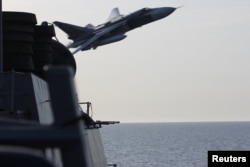NATO has a new supreme commander, whose job is to strengthen it as a defense force after years of reductions of U.S. troops in Europe.
"We face a resurgent Russia and its aggressive behavior that challenges international norms," U.S. Army General Curtis Scaparrotti said earlier this week upon taking command of U.S. forces in Europe.
He added that the Atlantic alliance's forces must be "ready to fight should deterrence fail."
Scaparrotti became supreme allied commander Europe at a May 4 ceremony at NATO's military headquarters near Mons, in southern Belgium.
His appointment comes at a time when the alliance regards Moscow as a threat to stability over its actions in Ukraine and has largely given up on military or civilian cooperation with Russia.
Scaparrotti has said he will press Washington to station a third permanent brigade of U.S. troops in Europe to bolster the two brigades presently deployed in Germany and Italy. Any additional permanent deployment of troops would reverse reductions over the past four years, during which Washington deactivated two brigades in Europe due to budget pressures and new threats in the Middle East and Asia.
Today, there are fewer than 65,000 U.S. military personnel permanently stationed in Europe, down from roughly 300,000 during the Cold War.
Scaparrotti's desire for more troops in Europe echoes the position of NATO's outgoing military commander, U.S. General Philip Breedlove. To date, however, Washington has preferred to rotate additional troops in and out of Europe rather than permanently station more on the continent.
The rotations have sought to reassure nervous NATO allies in the wake of Russia's annexation of Ukraine's Crimean Peninsula in 2014 and amid Kyiv's ongoing conflict with Russia-backed separatists in eastern Ukraine. Anxiety remains particularly high in the Baltics and Poland over a possible threat from Russia.
However, Scaparrotti's most immediate challenge could be to lay down a clear boundary beyond which NATO units will not tolerate mounting harassment by Russian forces.
Russian warplanes routinely buzz NATO warships in the Baltics and the Black Sea as both sides have stepped up military exercises in response to the Ukraine crisis. The close flybys have created growing concern that they could lead to a direct confrontation.
Scaparrotti has taken a tough line against the harassment, telling U.S. senators during hearings last month that the Russian flybys are deliberately provocative and dangerous.
"I think they're pushing our envelope in terms of our resolve," he said. He added that Russia needs to know the United States will take action if American lives were endangered.
He said one of his first actions as NATO's commander will be to review the rules of engagement for U.S. and allied forces regarding when to respond with force to safeguard their security.
Scaparrotti comes to the top NATO military post after serving as head of U.S. forces in South Korea.
Prior to that, he served in Iraq and Afghanistan.




![U.S. Army General Curtis Scaparrotti: "I think [the Russians are] pushing our envelope in terms of our resolve."](https://gdb.rferl.org/298c30d1-825d-4fc9-b6b5-a4aa471c5d98_cx0_cy5_cw0_w250_r1_s.jpg)



